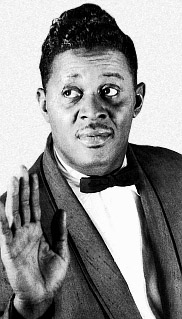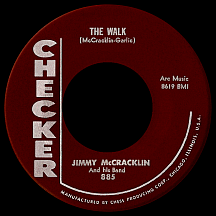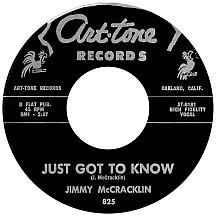JIMMY McCRACKLIN
The Walk
You wouldn't expect a career bluesman to be among the artists leading 1958's rock and roll dance movement, triggered by "The Stroll" (the first rock era dance to really cause a sensation) and the more specialized "Hand Jive" and "Freeze." But Jimmy McCracklin wasn't so rigid as to refuse to stretch his boundaries if it furthered his career. He created his biggest hit, "The Walk," after seeing a young couple on the dance floor doing a front-and-back walking motion. New dances of this sort emerged regularly for the next decade, an obvious consequence of the widespread popularity of American Bandstand, the much-watched teen dancefest that ABC-TV had picked up the previous August for coast-to-coast weekday consumption. A dozen years earlier, as the Atomic Age dawned and McCracklin began his career in music, he could scarcely have imagined the day he would be pandering to America's teenage gyrators, much less hobnobbing with Bandstand host Dick Clark. But it happened.
Rural Arkansas native James David Walker spent most of his childhood in St. Louis before joining the Navy in the late 1930s. After training to be a boxer, Jimmy claimed an impressive knockout rate in more than 60 matches during his service in Long Beach, California, punching away at his opponents while World War II raged overseas. A serious auto collision cut his face and left a scar above his eye that was evident for the rest of his life. It sidelined his boxing career, so he set out to make his way singing the blues and playing piano and harmonica under the McCracklin stage name. Working the small club scene in Los Angeles after his discharge, he soon found himself in a recording studio. "Miss Mattie Left Me" became his first 78 release on the Globe label; he sang to piano backing supplied by Jimmy Nichols (née Nicholson, he worked for years afterwards as a backing musician for many different blues artists). "Highway 101" followed, using a simple arrangement as before; when McCracklin began doing the piano part himself, the songs began to jump a little more. The upbeat "Rock and Rye," on the Courtney label, was curiously credited to Jimmy McCracken. Still, most of his early sides for Globe and a few smaller labels amounted to little more than standard blues...nothing too exciting!
McCracklin moved to Oakland and spent much of his career haunting both Southern Cal and Bay Area hot spots (he was a regular at the Club Savoy, "Granny" Johnson's bar/restaurant/gambling den in Richmond, several miles north of Oakland). He formed his Blues Blasters band, a talented outfit that featured, at various times, tenor saxophonist Johnny Parker, guitarist Alvin "Pee Wee" Parham and his longtime guitarist Lafayette Thomas; sax legend Maxwell Davis also took part in some recording sessions. A brief stint with Modern Records of Los Angeles produced a handful of slick tracks: "Bad Condition Blues" (credited to the Jimmie McCracklin Trio), Blues Blasters killers like "Rockin' All Day" and "The Panic's On," and a mellow blues number, "Love When it Rains," issued on RPM in 1951.
The band carried on with several 78s for Swing Time in '51 and '52, sometimes incorporating Latin rhythms. Signing with Houston, Texas label Peacock, tracks like "She Felt Too Good" and "The End" revealed a bit of Ray Charles' influence (they'd crossed paths at Swing Time)...not necessarily a bad thing! In 1955, Jimmy and the Blues Blasters returned to Modern (labels credited him as a "Triple A Artist - Piano-Harp-Vocal," giving the misleading impression of a one-man act). In '56 he made a couple of records for a small Oakland label, Premium, tailored more for the emerging rock and roll market; "Get Back," with a strong horn section, would have fit in nicely on radio's late-night rock specialty shows. McCracklin made a connection with transplanted Texan Bob Geddins, the owner of Oakland's Irma Records, and waxed several sides in '56 and '57. Still, he hadn't achieved a major breakthrough in more than ten years of trying.
Jimmy recorded "The Walk" independently in late 1957 with session time he paid for himself; it was as much a hipshakin' instruction record as an homage to dances old and new (Suzy-Q, chicken, cha-cha, Texas hop, fox trot, mambo). The master was picked up by Chess and released on the Checker imprint. In February '58, while people were lining up and "Stroll"-ing to The Diamonds' hit, kids began doing the walk-step, though Jimmy's catchy rhythm likely had more to do with his record's rapid rise to the top ten on pop and R&B charts the following month (Freddy King took note of the infectious bass line, later using it effectively in his great 1961 instrumental hit "Hide Away").

There was just one follow-up on Checker, "Get Tough," a good record with perhaps too much of a similarity to its hit predecessor. Mercury Records offered Jimmy a contract and he worked with producer Clyde Otis on some oddly against-type singles including two very fast-paced 1959 dance tracks, "The Wobble" and "Georgia Slop." He strayed furthest from his roots with the fifth Mercury single, an 'Uh-huh' ode to an unnamed dance, "What's That" ('...looks like the hoochie-coochie...'). There was a cool one-off single on Hi ("Things I Meant to Say") and then he started his own label in Oakland, Art-tone, in association with Geddins. Returning to the style he was most comfortable with, Jimmy composed and recorded the full-on blues track "Just Got to Know," which some would call his definitive moment (on the rhythm and blues charts it climbed as high as number two in December 1961). Previous labels (Chess and Kent, a subsidiary of Modern) sought to cash in on its success with releases of earlier recordings, but the next hit was the second on Art-tone: "Shame, Shame, Shame." Jimmy had taken control and it paid off!
He jumped at the chance to sign with Imperial Records and stayed for eight years, even as changes occurred that included a sale to Liberty Records. His most slickly-produced, and arguably best, recordings came during that time, as an onslaught of original material reached millions of fans likely unaware of his earlier blues work. Relationship highs and woes were a frequent subject of his lyrics as sales of singles and albums were brisk and radio play was strong, thanks to the many R&B-formatted atations dotting the landscape. "Every Night, Every Day" and "Arkansas (Part 1)" made some noise in 1965. Two of his biggest hits were recorded in Houston with Bobby Bland's longtime arranger Joe Scott; "Think" addressed the consequences of life's inevitable decisions ('...what kinda life would we have...just in case we both were wrong?') and "My Answer" made a strong case against reconciliation. One of his compositions, "Tramp," a hit for cowriter Lowell Fulsom, has become a standard.
In 1967, Liberty put him on Minit (the former New Orleans label that had also been purchased by Liberty) and what followed was a string of soul singles produced by Jimmy Holiday, Jimmy Lewis, Gene Dozier, Monk Higgins and other productive '60s soul men. McCracklin originals "Dog (Part 1)" and "Get Together" were minor hits during this period. Jimmy adapted; his music, in fact, frequently broke out of the mold of standard blues, incorporating other styles most bluesmen would shun. Jimmy McCracklin lived into his nineties, his career spanning some seven decades as 78s, 45s and LPs of his material stacked up, containing lyrical delights and compelling musical nuances that will be there for the exploring long after his 20th century heyday.



